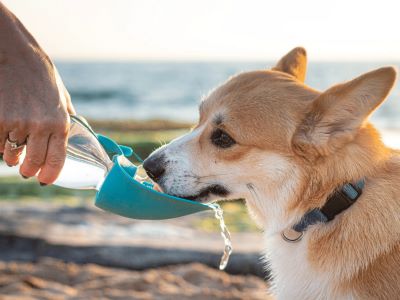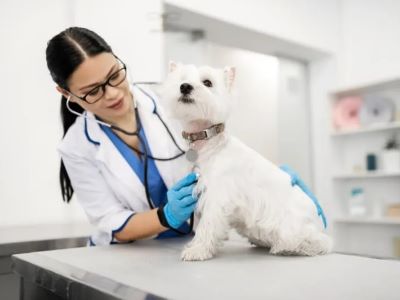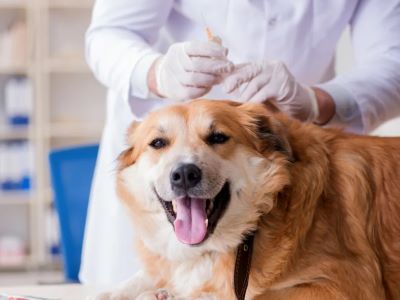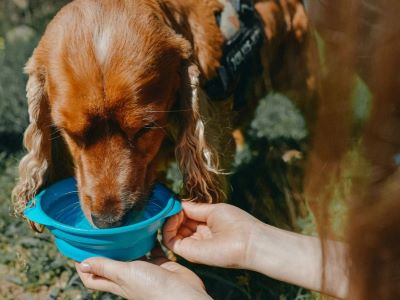It’s normal for dogs to start drinking a bit more water as they get older. But if your senior dog suddenly begins drinking a lot more than usual, it could be a sign of a health issue that needs attention. What Does It Mean When an Older Dog Starts Drinking a Lot of Water? Should you call the vet, or will it be okay soon?
As dogs age, conditions like kidney disease, diabetes, and Cushing’s disease can make them abnormally thirsty. Some medications and cognitive problems can too. If your older dog’s water bowl is constantly empty or they wake you up at night for more water, take note. Excessive thirst that comes on suddenly or keeps up for over a day needs to vet’s eye.
Tests can diagnose if illness is making your dog too thirsty. With treatment tailored to the cause, their drinking should return to normal. In the meantime, make wake easily available, take extra pee breaks, and monitor your pet. With vigilance and prompt vet care, you can help your senior dog stay happy, healthy and properly hydrated.

How Much Water Do Older Dogs Need?
Water is essential for dogs of all ages, but how much they need to drink can vary. The amount depends on size, activity level, and health status.
As a general guideline, the normal amount of water for an adult dog is around 1-2 ounces per pound of body weight per day. For example, a 50-pound dog typically needs 5-10 cups of fresh water daily.
Puppies, adolescents, and very active dogs may need more. Senior dogs tend to drink a bit less than when they were younger.
It’s important to always provide clean drinking water and monitor your dog’s intake. Noticeable increases or decreases in your older dog’s water consumption could signal an underlying health issue requiring veterinary attention. Excessive thirst can be a symptom of conditions like kidney disease, diabetes, and Cushing’s disease[1].
If your senior dog suddenly starts drinking a lot more than usual, contact your vet, especially if accompanied by other symptoms like increased urination, weight loss, or vomiting. Getting the cause diagnosed and treated early is key.
When Thirst Becomes Excessive

While increased water consumption can be normal as dogs age, excessive thirst can be a red flag. Signs your senior dog may be drinking too much include:
- Doubling their normal water intake over 24 hours
- Drinking water obsessively throughout the day
- Frequent emptying of the water bowl
- Excessive urination and accidents in the house
- Waking you up at night wanting more water
Several conditions can cause dogs to become abnormally thirsty. These include:
- Kidney disease[2] – Impairs the kidney’s ability to concentrate urine
- Diabetes – Causes glucose to spill into the urine, increasing thirst
- Cushing’s Disease – Leads to electrolyte imbalances
- Medications – Some drugs like steroids can trigger excessive thirst
- Cognitive dysfunction – Disorientation can cause dogs to drink more
As mentioned by Katie Grzyb, DVM in petmd, "Certain medications can cause increased thirst and urination. These medications include diuretics (such as furosemide or torsemide), anti-seizure medications (such as phenobarbital), and corticosteroids (such as prednisone)."
What to Watch Out For Along With Excessive Thirst
If your senior dog suddenly seems excessively thirsty, look out for accompanying signs and symptoms. Increased water consumption often goes hand-in-hand with:
- Urinating more frequently and having accidents around the house. The extra fluid intake leads to more urine output.
- Weight loss from urinating out glucose and calories. This may happen with undiagnosed diabetes.
- Loss of appetite or vomiting if in kidney failure. Toxins build up and create nausea.
- Lethargy and weakness if dehydrated or unwell. Dogs may drink more but not properly hydrate.
- Panting and appearing distressed if salts and electrolytes are imbalanced.
- Disorientation or restlessness with cognitive dysfunction syndrome in older dogs.
Also, note any recent changes like new medications, a switch in diet, or stressful events that preceded increased thirst.
When to Seek Veterinary Help

If your senior dog exhibits excessive thirst that persists for more than 24 hours, it’s important to make an appointment with your vet. Prolonged excessive water consumption can be a sign of serious illness requiring treatment.
Contact your vet right away if your dog's thirst is accompanied by concerning symptoms like:
- Repeated accidents and excessive urination
- Weight loss
- Lethargy, weakness, or loss of appetite
- Vomiting
- Confusion and Restless Pacing
Your vet will want to run some diagnostic tests on your dog, including:
- A complete physical exam to check for dehydration, fever, or an enlarged abdomen.
- A chemistry panel and urinalysis are to assess kidney function, and glucose levels, and look for infection.
- A complete blood count is to check for anaemia and infection.
- Diagnostic imaginings such as x-rays or ultrasounds to examine organs.
Getting to the root cause is crucial for proper treatment. Causes like kidney disease, diabetes, and adrenal disease all require different medications and ongoing management.
How Vets Diagnose the Excessive Thirst

If you bring your senior dog into the vet for drinking too much water, there are tools vets use to pinpoint the cause:
- Physical Exam – The vet will check for signs of dehydration, feel your dog’s abdomen for enlarged organs, take their temperature, and assess overall health.
- Lab Tests – A chemistry panel checks kidney function, glucose levels, and electrolyte balances. A urinalysis screens for infection, diabetes, and kidney disease.
- Blood Work – A complete blood count evaluates anaemia, infection, and hydration status. A biochemistry profile provides an overview of organ function.
- Imaging – X-rays or ultrasounds allow visual examination of organs to check for enlargement, stones, tumours, or structural changes.
- Urine Culture – A urine culture checks for hard-to-detect urinary tract infections. These are common in older dogs.
- Scope Exams – An endoscope lets vets inspect the bladder and urethra for abnormalities.
- Biopsy – A tissue sample may be taken if cancer is suspected.
Treatment of the Underlying Cause
The treatment for excessive theirs in dogs depends on the specific condition causing it. Some common treatment options include:
- Kidney Disease – This may involve IV fluids, a kidney-friendly diet, phosphorus binders, and medications to control anaemia, blood pressure, and nausea. Regular lab tests will monitor kidney functions.
- Diabetes Mellitus – Daily insulin injections, frequent blood glucose checks, a consistent feeding schedule, and medications to prevent diabetic complications are typical treatments.
- Cusing’s Disease – Medications to block excessive cortisol production by the adrenal glands. Lysodren and Trilostane are commonly prescribed.
- Infection – Antibiotics are prescribed based on bacterial culture results, along with medications for pain and inflammation. Strict rest and hydration may be advised.
- Medications – Adjusting for discontinuing medications that are causing increased thirst as a side effect.
- Cancer – Treatment options depend on the type and stage of cancer. This may include surgery, chemotherapy medications, radiation therapy, etc.
Tips for Managing Water Intake
If your senior dog is drinking excessively, here are some tips for managing their water intake at home while waiting to see the vet:

- Provide easy access to fresh, clean water at all times. Use bowls that are easy for the dog to reach and are stable.
- Limit water consumption 2-3 hours before bedtime to reduce overnight accidents. However, don’t restrict access to water overall.
- Take your dog outside to urinate frequently to avoid accidents. Let them out every 2-4 hours if urinating excessively.
- Monitor water intake and urination patterns to share with your vet. Measure water amounts if needed.
- Switch to wet food or add water to dry food to provide fluids. Avoid giving treats high in salt.
- Confine your dog to one area using baby gates to make cleaning up accidents easier. Use absorbent pads or beds.
- Make any recommended diet changes, like reduced protein for kidney disease.
- Give prescribed medications as directed by your veterinarian.
- Stay alert for any signs of worsening illness requiring urgent vet care.
FAQs
What Does It Mean When an Older Dog Starts Drinking a Lot of Water?
Excessive water intake in an order dog commonly signals an underlying medical condition requiring veterinary attention. Causes may include diabetes, kidney disease, infection, medication side effects, or other age-related illnesses. It’s important to monitor water consumption in senior dogs and contact your vet if excessive thirst persists to get proper diagnostic testing and treatment.
How much water should an older dog drink per day?
There’s no universal amount as it depends on size, health, activity, etc. But around 1-2 oz per pound of weight per day is a general guideline. Monitor for increases.
What health conditions cause dogs to drink excessively?
Kidney disease, diabetes, Cushing’s disease, infections, some medications, cognitive dysfunction syndrome, and more. See your vet.
My older dog is also urinating more. What does this mean?
Increased urination usually accompanies excessive thirst and signals an underlying medical condition needing treatment.
How is excessive thirst treated in dogs?
Treatment depends on the cause but may include medications, diet changes, surgery, chemotherapy, insulin, etc.
Conclusion
When an older dog starts drinking a lot more water than normal, it can signal a health problem. Excessive thirst that lasts over 24 hours, along with issues like increased urination or vomiting, needs the vet’s attention. Tests will diagnose if it is kidney disease, diabetes, infection, or another condition making your dog overly thirsty.
With proper treatment for the underlying illness, your dog should stop drinking excessively and return to a normal, healthy level of water intake. Monitor your senior dog’s thirst carefully and call your vet promptly about dramatic increases in drinking. Getting the right diagnosis and care can help resolve the problem and keep your older dog happy and hydrated.
Reference:
- Cushing’s syndrome. (2022, December 2). Cornell University College of Veterinary Medicine.
- Chronic Kidney Disease: Living with Your Pet and the Diagnosis. (n.d.). The College of Veterinary Medicine at Michigan State University.



